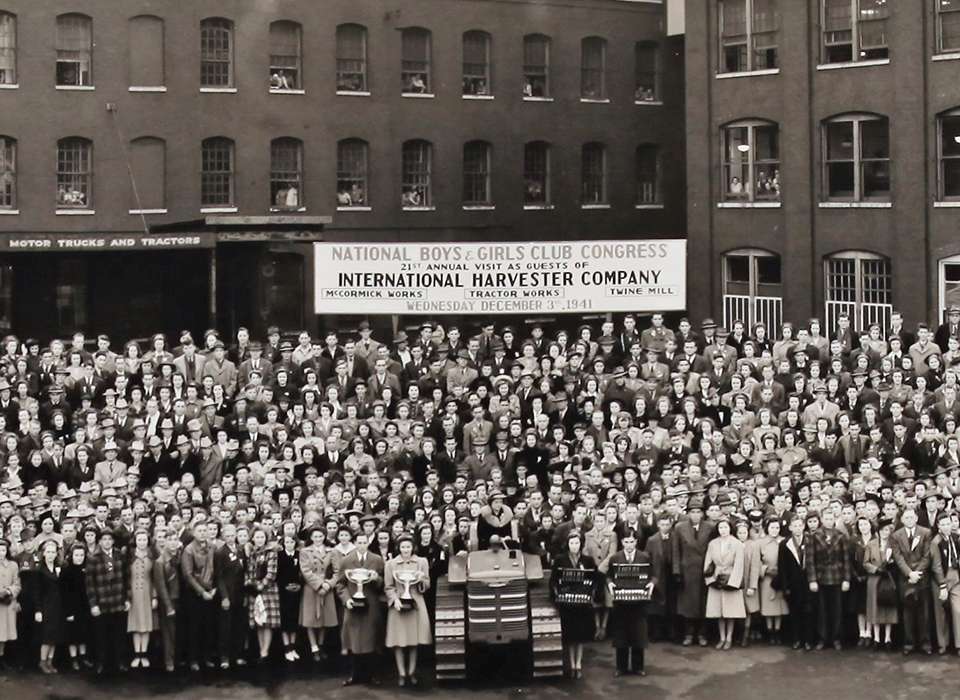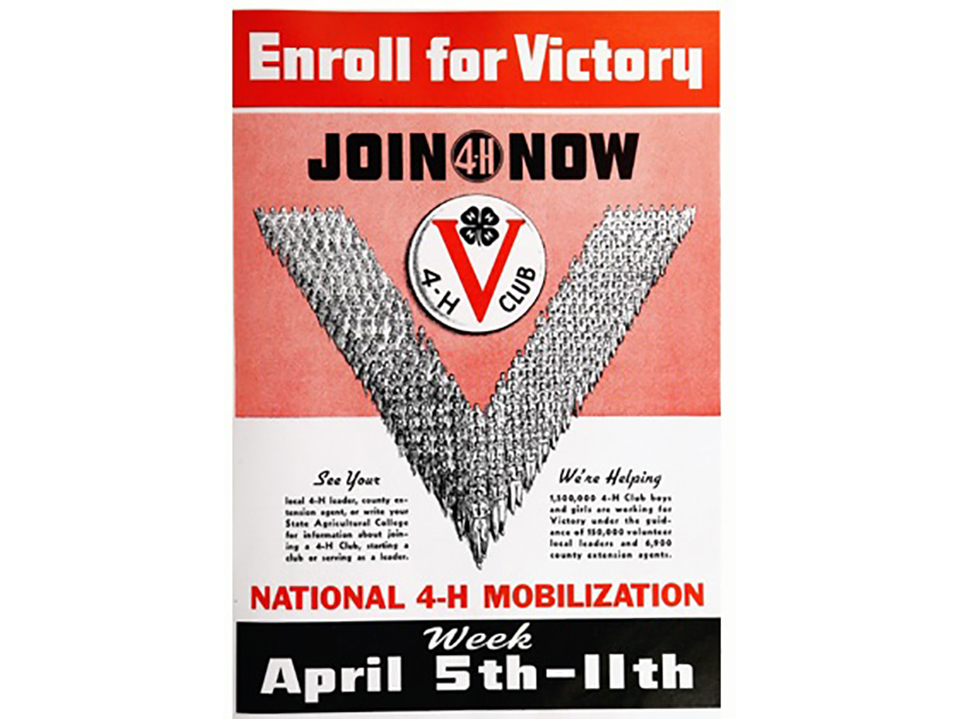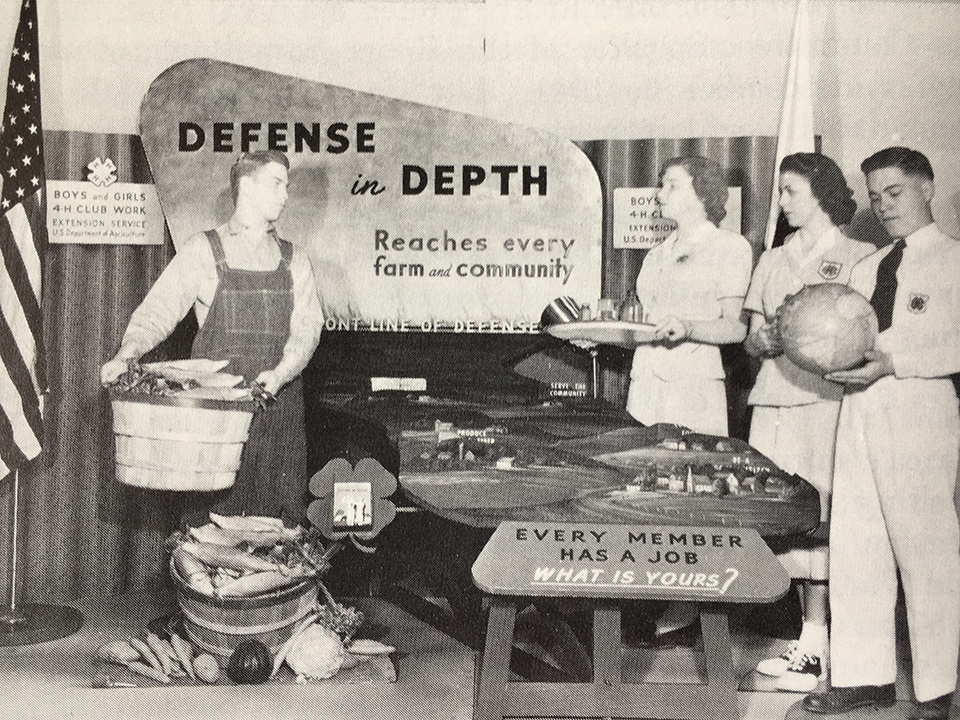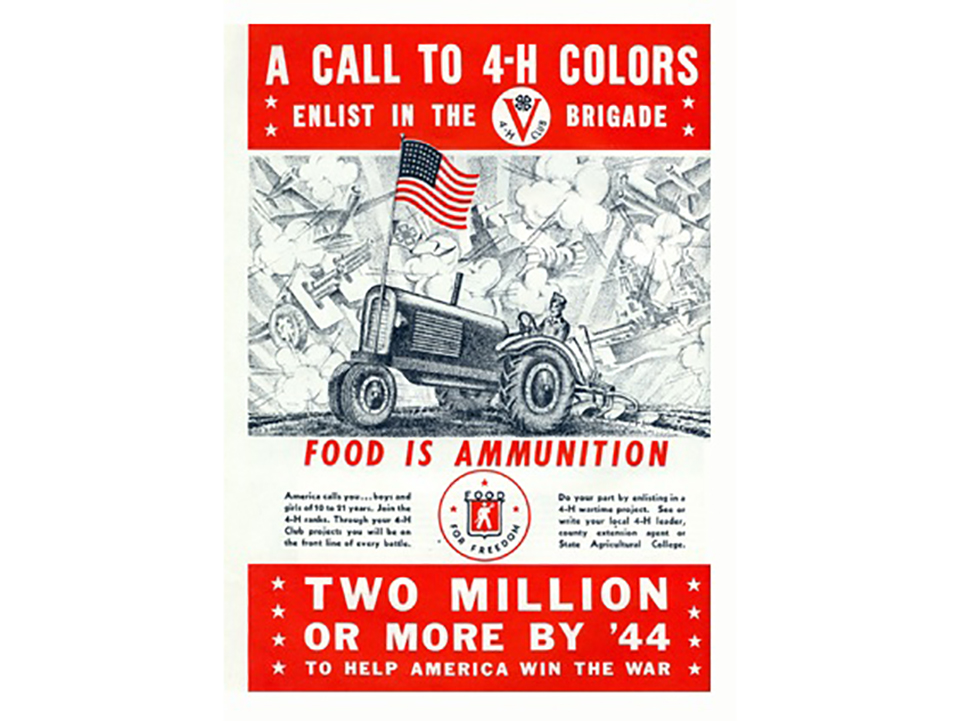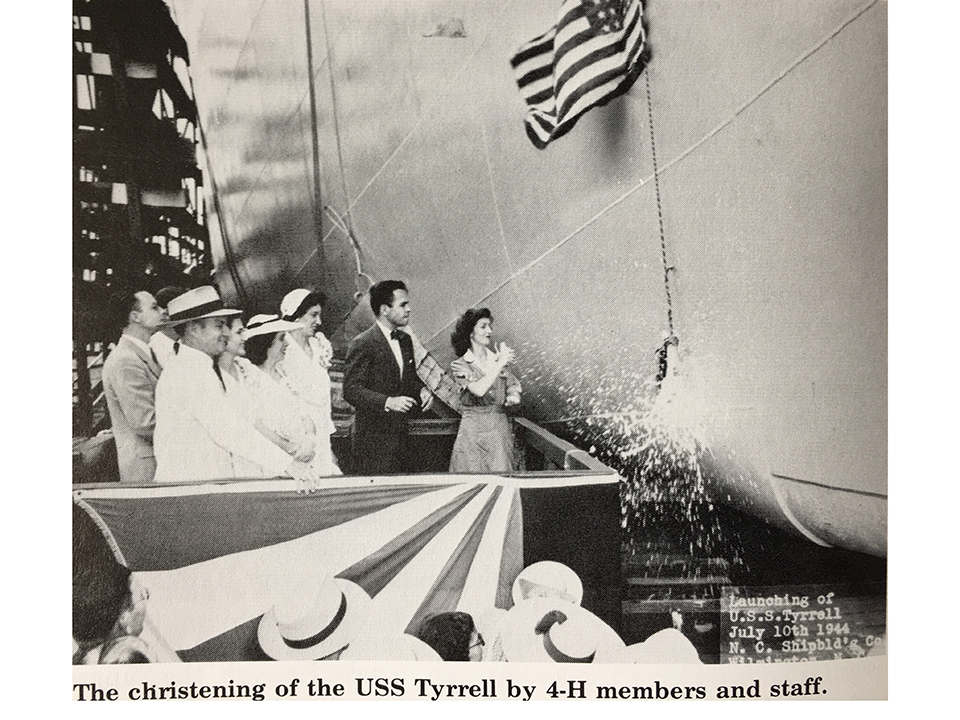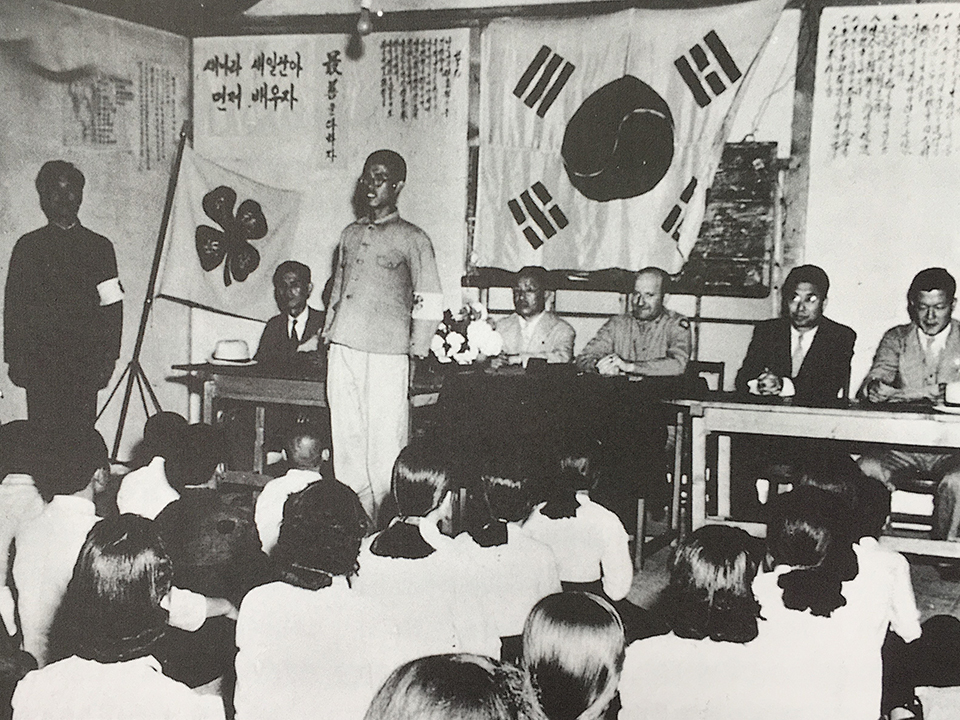Top Image: The National 4-H Congress from December 3, 1941. National 4-H History Preservation Collection image.
Life in America in the late 1930s was an uneasy peace. Members of the 4-H club worked on their projects, competed in fairs, attended camps and conferences, and worriedly went about their business even as violence engulfed Europe. Mindful of what was happening in Europe, Americans began to prepare for whatever might come.
The 4-H’ers attending the 1940 North Carolina State Fair were reminded by that year’s slogan that “The Best National Defense for Farm People is to Grow the Necessary Foods for Family Health - 4-H Club Members Do Their Part.” However, life went on as normal. In December 1941, 4-H’ers from across the country gathered in Chicago for the National 4-H Club Congress. The following photo, taken on December 3, 1941, is of the delegates, posing outside the International Harvester Company, which they had just toured. Most look carefree and happy, but by the time they returned home, the country was at war.
It was mid-afternoon on the East coast on Sunday, December 7, 1941 when news of the attack on US military forces at Pearl Harbor reached the mainland. Upon hearing the news, 4-H’ers, along with the rest of the country, set their minds to victory.The nation’s 4-H’ers contributed to the war effort in a number of ways. Of course, some members and former 4-H’ers enlisted or were drafted. One estimate of former 4-Her’s who served in World War II exceeds 800,000.
Marion J. Franklin went from being his Mount Vernon, Illinois 4-H Club President to Marine Gunnery Sergeant fighting in places like Saipan and Tinian in the Pacific theater. On November 11, 1944, he became old enough to vote.
Kenneth Otagaki raised chickens for the seven years he was a 4-H member on the Island of Molokai. He also received a degree from the University of Hawaii before he became a member of the 100th Infantry Battalion of the US Army. He ended his service in the war at Walter Reed Hospital in Washington, DC, recovering from combat wounds received at Cassina where he lost a leg, an eye, and several fingers.
Sgt. Oscar Godfrey Johnson was a five-year member of the Foster City, Michigan Sturgeon River 4-H Dairy Club and a few other 4-H clubs before he went off to Europe. He earned a Purple Heart and the 100th Congressional Medal of Honor, awarded to him by General Mark Clark.
Before Gen. Creighton W. Abrams commanded military operations in Vietnam, and served as Chief of Staff of the US Army from 1972 until shortly before his death in 1974,he served as tank battalion commander with Gen. Patton’s army during World War II. The October 1945 issue of National 4-H Club News announced that Col. Abrams returned home “in triumph” to Agawam, Massachusetts, the place where he began his career as a member of the 4-H Baby Beef Club.
Those at home did all they could to support the war effort, too. The Federal Extension Service, USDA, announced that 4-H’ers would help win the war by becoming more self-sufficient, allowing commercial products to be used to support our troops. Out of that need arose the National 4-H Club Victory Program with one week each year specially designated as “National 4-H Mobilization Week” when 4 H’ers were encouraged, and encouraged each other, to take action.
Spirit of the “V” Gardeners
Come on, Kids!
Here’s a royal Invitation
That ranks high in station.
We must not falter in our stride
On, On we are marching to Victory’s side
Growing Vegetables in rows and rows.
It isn’t the guy that crows; It’s the guy that a garden grows.
Join up today before you play.
Don’t wait until you’re old and grey.
It’s your will to do, not your age
That writes Victory on the final page.
Don’t ride in a cart,
Be a 4-H Clubber; do your part.
4-H’er Ramona Esty, age 11, Colorado, June 1942
In North Carolina they called it the “Feed a Fighter” Program. Maine called their program “4-H Food and Victory Campaign”. Maine’s Governor, Sumner Sewall, found it to be so important that he signed a proclamation making March 1942 4-H Enrollment Month. He urged “all boys and girls of club age to enroll in the 4-H Food for Victory projects.” An article in the February 2, 1943 edition of Augusta’s Daily Kennebec Journal reported that “15,000 Maine 4-H boys and girls produced over $340,000 worth of food in 1942.”
As for the 1943 program, it reported that the program “opened on February first and will continue through April fifteenth. February sixth to fourteenth has been set aside as National 4-H Mobilization Week.” According to Campaign officials, “Uncle Sam isn’t asking the boys and girls to give away to the armed forces the food they have raised — just eat it at home, and buy less. The more we have to buy, the more we are taking away from the boys in the armed forces who can’t raise gardens, pigs, chicks, etc.”
The program proved to be a national success. Just the numbers announced for 1942 alone are impressive: 3 million bushels of garden products; 6.5 million chickens raised; 85,000 head of dairy cattle; 300,000 head of swine; 146 million pounds of scrap metal collected; 23 million pounds of rubber collected; 24 million pounds of paper and burlap; $6 million in War bonds or stamps purchased; over a half million girls and boys remade or repaired clothing; 25,000 engaged in air-raid activities, and 450,000 engaged in other defense activities. The collections of scrap metal alone total an amount equivalent to 20 trainloads, each of approximately 100 cars.
Of course, vegetables and animals were not the only items needing to be “conserved.” As soon as the war started, 4-H girls in Massachusetts contributed some 6,000 articles of clothing for war relief, including bomb bags to carry supplies to shelters. The number one priority in Minnesota’s clothing program was sewing machine repair and cleaning, since new machines would be difficult to come by. Mrs. John G. Davis, leader of the Happy Hearts 4-H Club in Auburn, New Hampshire, reported in the February 1943 issue of National 4-H Club News that her girls completed 250 articles of clothing for the Red Cross in 1942, such as bed jackets, night dresses, mittens, shirts, sleepers, and slips.
They were also busy collecting paper, magazines, rubber, and iron for scrap drives and working in neighbors Victory Gardens, while still finding time for their regular 4-H projects like canning 1,580 jars of fruits and vegetables. Mrs. Lewis A. Smith, 4-H Club leader of the Walbert’s 4-H Ambitioners Club near Allentown, Pennsylvania, reported that the 34 girls in the club made and folded 24,884 bandages for a local hospital and have been working on quilts donated to the local Red Cross chapter. These were just a few of the many examples from across the country and across the war years.
War Bonds were also sold by 4-H members. If enough were sold, the club was invited to name a Liberty Ship (with an average cost of $2 million each). Fifty ships received 4-H Names from 43 states, with some states naming more than one. Ambulances, planes, and equipment were also purchased; all made possible by 4-H members. They even collected Milkweed pods to harvest the floss which was used in life jackets!
When all was said and done, based on estimates from State 4-H Administrators’ reports submitted in 1942 to 1945, 4-H War Bond sales totaled over $200 million; over 400 million pounds of scrap was collected; over 2 million acres in gardens and field crops raised; 74 million quarts were canned; and 43 million birds and 2.7 million head of livestock were raised.
When the war ended in 1945, a 4-H Victory Campaign/4-H Mobilization Week was no longer needed. However, the program was so effective that the Federal Extension Service kept the week, calling it National 4-H Week, which has been celebrated annually in October ever since.
With 4-H’ers spread throughout the world by the military, the idea of 4-H spread too. After the war, programs were established in Europe, Asia, Africa, and the Americas, encouraging “Learning by Doing and World Peace.” Some soldiers, each former 4-H’ers, realized that they felt less anger at the Germans they had become acquainted with through the club than the “anonymous” Germans they faced on the battlefields. Out of that idea grew the International Four-H Youth Exchange Program (IFYE).
The transition back to peace-time was, although very welcome, not as easy as might be expected. Without Victory Gardens and other similar activities, the country experienced shortages. Returning soldiers flooded the job market. However, the message of 4-H to “Learn by Doing to Make the Best Better” inspired Americans even when faced with these postwar challenges.
For more information about 4-H during World War II, please visit the National 4-H History Preservation Program.
Meet the Author
Ron Drum was a Pennsylvania 4-H Member from 1967-1977. He holds a Bachelor’s Degree in Community Development from Pennsylvania State University and a Master’s Degree in Human Services Management from Worcester State University. During his 40-year 4-H/Positive Youth Development career, he has held positions with the State 4-H Offices of Maine and Massachusetts, at National 4-H Council; as a consultant to CSREES, USDA, and as an advisor to the 4-B Program of the Botswana Ministry of Agriculture. He currently resides in Drums, PA with his wife, Phyllis, and son, Philip.
Cite this article:
MLA Citation:
APA Citation:
Chicago Style Citation:
